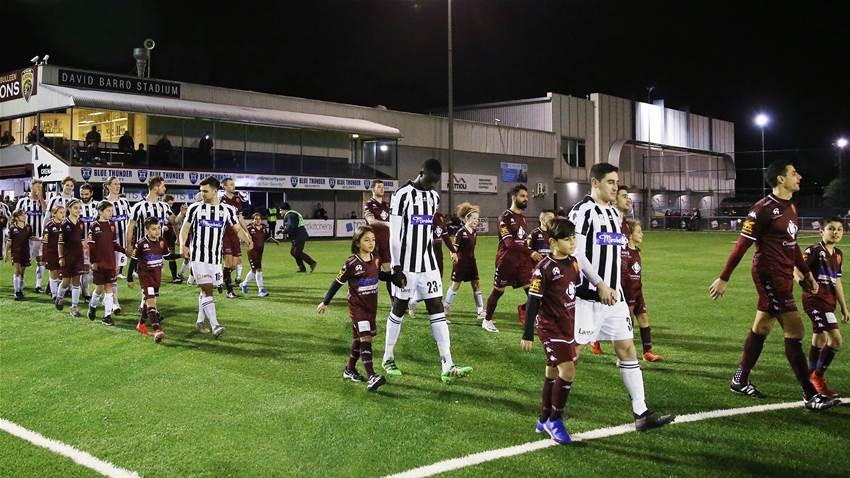Football Victoria (FV) has become the latest Member Federation to announce staffing stand-downs and wage reductions in the face of the COVID-19 crisis sweeping the globe.
In a Tuesday afternoon release, Victorian football's governing body announced that over 50% of its workforce would be stood-down for one month commencing April 1, with those staff affected granted access to annual leave and long service leave entitlements for the duration of the shutdown.
Those that remain at the organisation will operate with reduced hours and pay - tasked with supporting local clubs and planning for the resumption of footballing activities.
As part of the announcement, FV has indicated that its five-person executive team will undertake an average 40% pay reduction and the organisation will explore the Federal Government's newly announce JobKeeper program to retain as much staff as possible.
National Premier League and grassroots football were suspended by the FFA on March 17 as the scale of the threat posed by COVID-19 became apparent, with the decision earmarked for review by the FFA’s National COVID-19 Working Committee by April 14.
The A-League then followed on March 24, with that suspension tapped for review on April 22.
As part of Tuesday's release, however, FV indicated that it did not expect that restrictions imposed by the Victoria State Government would allow for the resumption of local footballing activities by that date.
As a result, the FFA and Member Federations are instead exploring avenues of extending the suspension of football beyond April 14.
“These are extraordinary times, which call for extraordinary action to ensure the financial viability and long-term sustainability of our game across Victoria,” FV CEO Peter Filopoulos said.
“It’s gut-wrenching for everyone involved in the game, and I’m acutely aware of the impact that stand-downs will have on the lives of our people.
“However, it’s vital that the organisation is fit-for-purpose during this period, and remains agile and responsive so that we’re in a position to get through the significant challenges facing us right now and be able to resume football activities down the track.
“Over the past couple of years, the team’s been working hard to develop and deliver on our strategic plan, FootbALLways. I’m immensely proud of them, and I’m humbled by the way the Victorian football community has responded to this unprecedented crisis by taking the appropriate precautions to ensure people stay safe and healthy.
“As an organisation, we’ve had to take measured action quickly and we’ve sought to keep our staff and clubs fully informed during this challenging period, with the absolute focus being on their health and well-being, and to support them as well as we possibly can.”
“The COVID-19 health crisis continues to evolve and challenge us with many uncertainties and unknowns. Our focus at this time is to look out for our people and clubs so they can take care of themselves and their families, and we will support our staff however we can if they choose to seek alternative employment during the period of the shutdown.
“Hopefully, the Federal Government’s latest income relief package will go some way to stemming the number of people we have to stand down.”
“Beyond that, we’re working tirelessly in the background in anticipation of resuming football activities as soon as we can overcome the significant challenges facing us right now.
“This involves comprehensive scenario planning in consultation with member clubs, local government and the broader community to enable the reactivation of as many of the 40,000 fixtures we stage each season across all levels of football.
“In the meantime, we appreciate the patience and incredible support of the Victorian football community, the lifeblood of our game.”
Member Federations have been left considerably in the lurch by football’s COVID-19 enforced hibernation, with their season – unlike the summer hosted A-League – only in its infancy.
NPL Victoria - which was experiencing a surge in interest thanks to streaming deals and a push for a national second division - had completed five rounds of its regular season prior to grassroots football’s hibernation, with NPLW, NPL2, NPL3 and state-league football set to commence the week of.
The suspension has also led to questions about club and participation fees for clubs and individuals involved in the grassroots of Victorian football.
FV has, in an email sent to club president’s and seen by FTBL, encouraged its clubs to continue to register its clubs in order to allow the organisation to “continue to monitor, manage and prepare for the remainder of 2020”
Advice to clubs surrounding registration refunds is then detailed.
“While football is suspended, the sport needs participants to continue supporting their clubs by registering to play. This is crucial to ensure the sustainability of the competitions football is aiming to still deliver in 2020 if/when play can resume,” the email reads.
“Clubs remain obliged to pay any Competition Administration or registration fee, Zone/Association fee (if applicable), Member Federation fee and FFA’s National Registration Fee (Governing Body costs) out of the registration fees they collect per participant. Clubs should consider this before agreeing to provide full refunds to any participant.
“In the event that the Competition Administrator, Zone/Association, Member Federation or FFA (as applicable) in future determines to refund any Governing Body costs to a participant, those Governing Body costs will be returned to the club for the purpose of providing a refund to the participant.
“If and when a decision is made to provide a refund of Governing Body costs, clubs should note that there may be circumstances where a full refund of a Governing Body cost is not appropriate. This may be the case where certain services have already been accessed by the participant (such as an insurance policy that was made available for when the participant took part in matches and/or training). Similarly, clubs may have already provided apparel or other products and services they consider to be non-refundable. A pro-rata refund (if any) of a Governing Body cost may be more appropriate in a given case. Each Governing Body will need to assess this in the future but only once the full extent of the current disruption is better understood.”
Related Articles

2025 start date set for football's new second tier

A-League champs in shock Australia Cup exit













